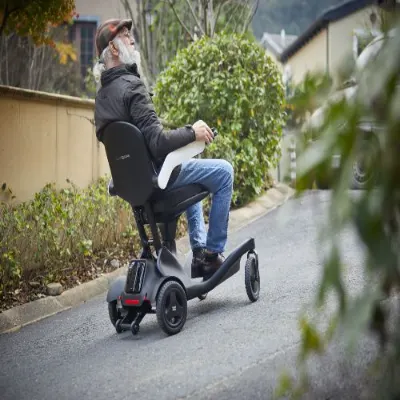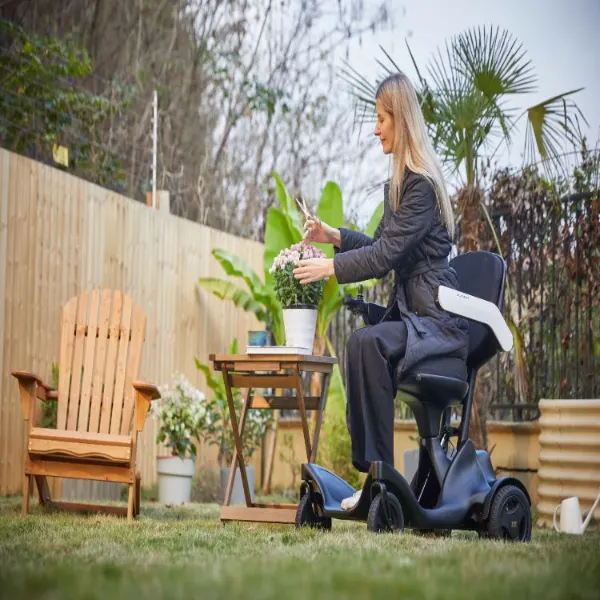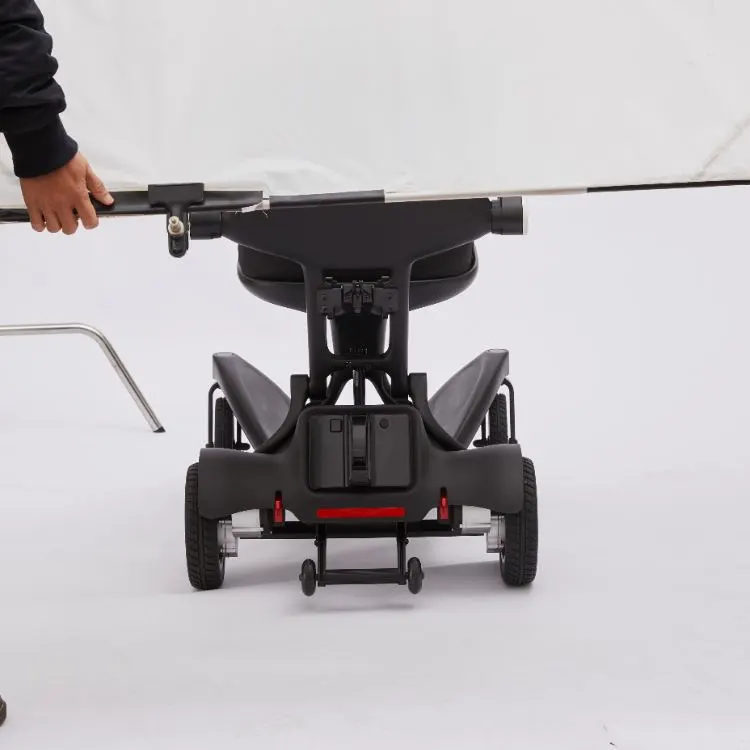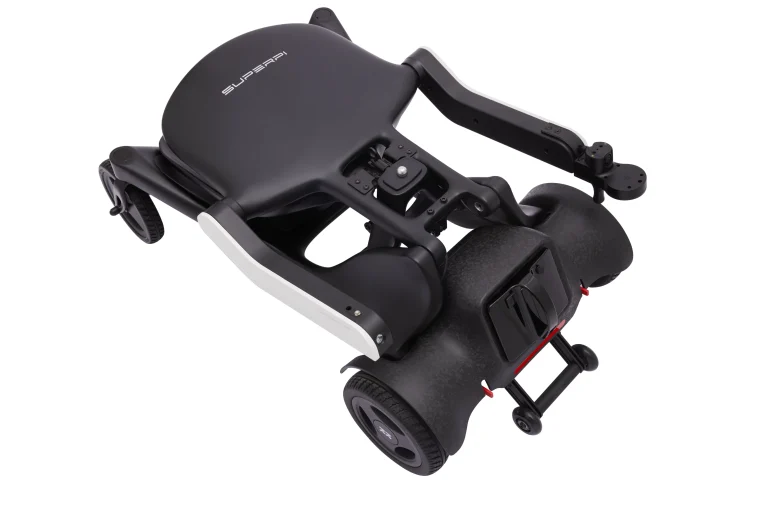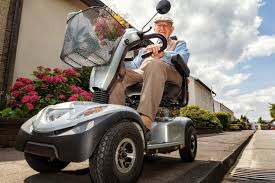
Why Safety Matters for Mobility Scooter UsersMobility scooters empower seniors to maintain independence, but their safe operation is critical to prevent accidents and injuries. According to a 2019 study published in the Journal of Safety Research, mobility scooter-related injuries are on the rise, with seniors over 65 accounting for a significant portion of incidents. Common accidents include collisions with obstacles, tipping on uneven terrain, or falls during transfers. These risks are heightened for seniors due to age-related declines in vision, hearing, balance, or reaction time.Safe use of mobility scooters involves understanding the device’s capabilities, practicing proper operation techniques, and being aware of environmental hazards. By following safety guidelines, seniors can confidently use scooters for errands, social outings, or travel while minimizing risks. This guide covers preparation, operation, environmental considerations, maintenance, legal requirements, and emergency preparedness to ensure a secure and enjoyable experience.
Section 1: Preparing to Use a Mobility Scooter SafelyBefore operating a mobility scooter, seniors and caregivers must take steps to ensure the user is physically and mentally prepared, the scooter is suitable, and the environment is safe.1.1 Assessing Physical and Cognitive CapabilitiesNot all seniors are suited to operate a mobility scooter, as it requires specific physical and cognitive abilities. Key considerations include:
- Upper Body Strength and Dexterity: Scooters are controlled via a tiller (handlebar) and hand-operated throttles. Seniors with limited hand strength, arthritis, or tremors may struggle with steering or speed control. Delta tillers, which allow operation with both hands, are ideal for those with reduced dexterity.
- Balance and Stability: Users must maintain an upright seated position and have sufficient balance to avoid leaning or falling, especially on turns or inclines. Four-wheel scooters offer greater stability for those with balance issues.
- Vision and Hearing: Good vision is essential for spotting obstacles, pedestrians, or traffic. Hearing impairments may limit awareness of environmental sounds like horns or warnings. Regular vision and hearing tests (annually, as recommended by the CDC) ensure users can operate safely.
- Cognitive Function: Operating a scooter requires quick decision-making and spatial awareness. Seniors with cognitive impairments, such as dementia, may need supervision or alternative mobility aids like wheelchairs.
Action Steps:
- Consult a healthcare provider or occupational therapist to assess suitability for scooter use.
- Consider a test drive at a retailer (e.g., United Access, SpinLife) to evaluate comfort and control.
- If limitations are significant, explore power wheelchairs with joystick controls for easier operation.
1.2 Choosing the Right Mobility ScooterSelecting a scooter that matches the user’s needs and environment is critical for safety. Key factors include:
- Type of Scooter:
- Travel Scooters: Lightweight (22–100 pounds), ideal for indoor use or smooth surfaces. Example: Pride Go-Go Elite Traveller ($1,200).
- Mid-Size Scooters: Versatile for indoor and outdoor use, with ranges up to 20 miles. Example: Pride Victory 10 ($2,000).
- Heavy-Duty Scooters: Built for outdoor terrain, with weight capacities up to 500 pounds. Example: Afikim Afiscooter S4 ($5,000–$7,000).
- Wheel Configuration:
- Three-Wheel Scooters: Offer tighter turning radii (30–45 inches) but less stability on uneven surfaces.
- Four-Wheel Scooters: Provide greater stability, ideal for outdoor use or users with balance concerns.
- Capacité de poids: Ensure the scooter supports the user’s weight plus any cargo (e.g., groceries, oxygen tanks).
- Turning Radius: For indoor use, choose a scooter with a turning radius (e.g., 30–40 inches) that fits narrow spaces like doorways (measure for 2-inch clearance loss with hinged doors).
- Caractéristiques de sécurité: Look for anti-tip wheels, automatic brakes, headlights, taillights, reflectors, and seat belts.
Action Steps:
- Match the scooter type to the primary environment (indoor, outdoor, or mixed).
- Verify weight capacity and turning radius suit the user’s needs.
- Prioritize models with robust safety features (e.g., Pride Mobility, Golden Technologies).
1.3 Training and FamiliarizationEven user-friendly scooters require practice to master. Training reduces the risk of accidents by building confidence and skill.
- Manufacturer Training: Some retailers (e.g., Zip’r Mobility) offer training sessions or manuals. Request a demonstration when purchasing.
- Practice in a Safe Environment: Start in an open, flat area like a driveway or parking lot to practice starting, stopping, turning, and reversing.
- Learn Controls: Familiarize yourself with the throttle, speed settings (turtle/rabbit modes), and emergency brake procedures.
- Simulate Scenarios: Practice navigating obstacles, tight spaces, or slight inclines to build confidence.
Action Steps:
- Schedule a training session with the retailer or a mobility specialist.
- Practice for 1–2 hours in a controlled setting before using the scooter in public.
- Keep the user manual handy for reference.
Section 2: Operating a Mobility Scooter SafelySafe operation involves mastering the scooter’s controls, maintaining awareness, and following best practices for navigation.2.1 Mastering the Controls
- Throttle Control: Most scooters use a thumb or finger throttle to control speed. Apply gentle pressure to avoid jerky movements. Practice gradual acceleration and deceleration.
- Speed Settings: Use lower speeds (e.g., 1–2 mph) indoors or in crowded areas; higher speeds (up to 4–8 mph) are suitable for open outdoor spaces.
- Steering: Use smooth, controlled movements to turn the tiller. Avoid sharp turns, which can cause tipping, especially on three-wheel scooters.
- Braking: Scooters have automatic brakes that engage when the throttle is released. Test brakes regularly and avoid sudden stops on slopes.
Action Steps:
- Practice throttle control to achieve smooth starts and stops.
- Adjust speed settings based on the environment (e.g., low for stores, medium for sidewalks).
- Test brakes before each use, especially on inclines.
2.2 Maintaining Situational Awareness
- Scan the Environment: Constantly check for pedestrians, vehicles, or obstacles. Look over your shoulder before turning or reversing.
- Avoid Distractions: Do not use a phone, listen to music, or engage in conversations while operating the scooter.
- Be Visible: Use headlights, taillights, and reflectors in low-light conditions. Add reflective tape or a flag for extra visibility.
- Listen for Cues: Pay attention to sounds like car horns, sirens, or pedestrian warnings, especially if hearing is impaired.
Action Steps:
- Perform a 360-degree scan before moving in busy areas.
- Equip the scooter with lights and reflectors for evening or early morning use.
- Consider a hearing aid if auditory cues are difficult to detect.
2.3 Safe TransfersGetting on and off the scooter can be a fall risk, particularly for seniors with balance issues.
- Stable Positioning: Park the scooter on a flat, stable surface and engage the parking brake (if available) or turn off the power.
- Use Support: Hold onto armrests or a nearby stable surface when transferring. Swivel seats can ease transitions.
- Avoid Rushing: Take time to ensure footing is secure before standing or sitting.
- Caregiver Assistance: If balance is a concern, have a caregiver assist during transfers.
Action Steps:
- Practice transfers in a controlled setting with supervision.
- Install a swivel seat or transfer board for easier transitions.
- Keep a cane or walker nearby for added support.
Section 3: Navigating Different EnvironmentsMobility scooters are used in diverse settings, each with unique challenges. Understanding how to navigate these environments safely is crucial.3.1 Indoor Use
- Tight Spaces: Use a compact, three-wheel scooter with a tight turning radius (30–40 inches) for hallways, doorways, or stores. Measure doorways to ensure clearance.
- Obstacles: Watch for furniture, rugs, or thresholds that can cause tipping. Remove or secure loose rugs.
- Crowded Areas: In stores or malls, use low speeds (1–2 mph) and yield to pedestrians. Avoid busy hours if possible.
- Elevators: Ensure the scooter fits in elevators (check dimensions: typically 30–40 inches wide). Enter slowly and face forward.
Action Steps:
- Map out indoor routes to identify potential obstacles.
- Practice navigating tight spaces at home before venturing into public areas.
- Check store accessibility (e.g., ramps, wide aisles) in advance.
3.2 Outdoor Use
- Sidewalks and Paths: Stick to paved sidewalks or designated paths. Four-wheel scooters with larger tires (8–12 inches) are better for uneven surfaces.
- Inclines and Slopes: Avoid steep inclines (over 6–8 degrees, depending on the scooter’s specs). Approach slopes head-on, not at an angle, to prevent tipping.
- Conditions météorologiques: Avoid wet or icy surfaces, which reduce traction. Use a canopy or weatherproof cover in rain, but ensure visibility is not obstructed.
- Crossings: Use pedestrian crosswalks and obey traffic signals. Be cautious of vehicles, as scooters are less visible than cars.
Action Steps:
- Check the scooter’s manual for maximum incline ratings (e.g., 6–10 degrees).
- Equip the scooter with all-terrain tires for outdoor use (e.g., Afikim S4).
- Carry a weatherproof poncho for unexpected rain.
3.3 Mixed Environments
- Transitions: Be cautious when moving between indoor and outdoor surfaces (e.g., thresholds, ramps). Slow down to avoid jolts.
- Public Spaces: In parks or community centers, prioritize pedestrian safety and use audible signals (e.g., a horn) to alert others.
- Terrain Changes: Avoid sudden transitions from pavement to grass or gravel, which can cause instability.
Action Steps:
- Choose a mid-size scooter (e.g., Pride Victory 10) for versatility.
- Practice transitioning between surfaces in a safe area.
- Plan routes to minimize terrain changes.
Section 4: Safety Features to PrioritizeModern mobility scooters come equipped with features designed to enhance safety. Understanding and utilizing these features is essential.4.1 Anti-Tip Wheels
- Purpose: Prevent tipping on inclines or uneven surfaces, especially on three-wheel scooters.
- Usage: Ensure anti-tip wheels are intact and positioned correctly before each use.
- Entretien: Check for wear or damage during regular inspections.
4.2 Lighting and Visibility
- Headlights and Taillights: Essential for low-light conditions (e.g., dusk, dawn). Use even in overcast weather.
- Reflectors: Standard on most scooters but can be supplemented with reflective tape or a safety flag.
- Turn Signals: Indicate direction changes in crowded or traffic-heavy areas.
Action Steps:
- Test lights before evening use.
- Add reflective tape to the scooter’s frame or basket for extra visibility.
- Use a high-visibility flag in busy areas.
4.3 Braking Systems
- Automatic Brakes: Engage when the throttle is released, preventing rollaways. Test brakes before each use, especially on slopes.
- Emergency Brakes: Some models have a manual brake for emergencies. Familiarize yourself with its location and operation.
Action Steps:
- Practice braking on flat and sloped surfaces.
- Report brake issues to the retailer immediately.
4.4 Seat Belts and Stability
- Seat Belts: Available on some heavy-duty models (e.g., Afikim S4). Use them on high-speed scooters or uneven terrain.
- Low Center of Gravity: Four-wheel scooters or models with wider wheelbases reduce tipping risks.
- Répartition du poids: Avoid overloading baskets or carrying heavy items that could unbalance the scooter.
Action Steps:
- Fasten the seat belt (if available) during outdoor use.
- Choose a four-wheel scooter for users with balance concerns.
- Distribute cargo evenly in baskets or under-seat storage.
4.5 GPS and Emergency Alarms
- GPS Alarms: Some scooters (e.g., high-end models from Golden Technologies) include GPS or emergency call buttons for locating the user or signaling for help.
- Personal Alarms: Carry a separate medical alert device (e.g., Life Alert) for emergencies.
Action Steps:
- Test GPS or alarm systems regularly.
- Program emergency contacts into the system.
- Carry a charged phone for backup communication.
Section 5: Maintenance for Safe OperationRegular maintenance ensures the scooter remains reliable and safe. Neglecting maintenance can lead to malfunctions, such as brake failure or battery issues.5.1 Battery Care
- Charging: Charge the battery nightly, even after short trips, to maintain capacity. Use the manufacturer’s charger to avoid damage.
- Stockage: Store batteries above 32°F (0°C) for lithium-ion models or in a dry, cool place for SLA batteries.
- Replacement: Replace SLA batteries every 1–2 years ($100–$300) or lithium-ion batteries every 5–10 years ($200–$500).
Action Steps:
- Follow the charging schedule in the user manual.
- Check battery connections for corrosion monthly.
- Replace batteries through the retailer or manufacturer.
5.2 Tire Maintenance
- Inspection: Check tires for wear, punctures, or low pressure before each use. Outdoor scooters with larger tires (8–12 inches) require frequent checks.
- Replacement: Replace worn tires ($20–$100) to maintain traction and stability.
- Terrain Suitability: Ensure tires match the environment (e.g., pneumatic tires for all-terrain use).
Action Steps:
- Inspect tires weekly for signs of wear.
- Replace tires through a certified dealer to ensure compatibility.
- Avoid overinflating pneumatic tires (follow manufacturer guidelines).
5.3 General Inspections
- Frame and Controls: Check for loose bolts, damaged seats, or worn tillers. Tighten or repair as needed.
- Brakes and Motors: Test brakes and listen for unusual motor noises. Schedule professional servicing annually.
- Cleaning: Wipe down the scooter weekly to remove dust or debris, especially around controls and wheels.
Action Steps:
- Perform a pre-use checklist: brakes, lights, tires, and battery.
- Schedule annual servicing with the retailer or manufacturer.
- Keep a maintenance log to track inspections and repairs.
5.4 Storage
- Indoor Storage: Store compact scooters in a dry, accessible area like a closet or hallway.
- Outdoor Storage: Use a weatherproof cover or shed for larger scooters. Avoid extreme temperatures or humidity.
- Security: Use a lock or GPS tracker to prevent theft, especially for outdoor storage.
Action Steps:
- Purchase a weatherproof cover for outdoor scooters ($50–$150).
- Store batteries separately if the scooter is unused for weeks.
- Install a lock for scooters stored in public areas.
Section 6: Legal and Regulatory ConsiderationsUnderstanding local regulations ensures safe and legal scooter use, particularly in public spaces.6.1 U.S. Regulations
- No License Required: Mobility scooters are classified as assistive devices under the Americans with Disabilities Act (ADA), requiring no driver’s license.
- Speed Limits: Some areas restrict sidewalk speeds to 4 mph. Check local ordinances.
- Public Access: Scooters are permitted in ADA-compliant spaces (e.g., stores, parks) but must yield to pedestrians.
- Road Use: Road-legal scooters (e.g., Class 3 in the UK, equivalent to heavy-duty models) may require registration in some regions, though rare in the U.S.
Action Steps:
- Contact local authorities (e.g., DMV, city hall) to confirm sidewalk or road restrictions.
- Carry a copy of the ADA guidelines for public access disputes.
- Register road-legal scooters if required (uncommon in the U.S.).
6.2 Medicare and Insurance
- Medicare Coverage: Medicare Part B may cover scooters if deemed medically necessary, requiring a prescription and Certificate of Medical Necessity (CMN).
- Private Insurance: Some plans cover scooters partially or fully. Verify with the provider.
- Documentation: Keep records of medical necessity for reimbursement claims.
Action Steps:
- Consult a doctor for a prescription if seeking Medicare coverage.
- Contact insurance providers to confirm coverage details.
- Retain receipts and warranty information for claims.
Section 7: Emergency PreparednessBeing prepared for emergencies ensures safety in unexpected situations, such as breakdowns or accidents.7.1 Handling Breakdowns
- Battery Failure: Carry a charged phone to call for assistance. Know the scooter’s range to avoid stranding.
- Mechanical Issues: Keep the retailer’s contact information and warranty details handy. Some brands (e.g., Pride Mobility) offer roadside assistance.
- Spare Parts: Carry a spare tire or basic tools for minor repairs (e.g., tightening bolts).
Action Steps:
- Program emergency contacts into your phone.
- Carry a small repair kit (e.g., tire patch, wrench).
- Know the nearest mobility scooter repair shop.
7.2 Dealing with Accidents
- Minor Collisions: If the scooter collides with an obstacle or pedestrian, stop immediately, assess damage, and exchange contact information if needed.
- Falls or Injuries: Use a GPS alarm or medical alert device to call for help. Stay calm and avoid moving if injured until help arrives.
- Reporting: Report serious accidents to local authorities and the scooter retailer for insurance or warranty claims.
Action Steps:
- Carry a first-aid kit for minor injuries.
- Memorize or store emergency procedures in the user manual.
- Inform family or caregivers of your routes for accountability.
7.3 Weather-Related Precautions
- Rain: Use a canopy or poncho to stay dry, but ensure controls remain accessible. Avoid deep puddles to protect the motor.
- Cold Weather: Store batteries above 32°F to prevent damage. Dress warmly to avoid hypothermia.
- Heat: Avoid prolonged exposure to direct sunlight, which can overheat the motor or battery.
Action Steps:
- Check weather forecasts before outings.
- Equip the scooter with a canopy for rain or sun protection.
- Carry insulated clothing for cold weather.
Section 8: Accessories for Enhanced SafetyAccessories can improve safety and functionality, making scooters more user-friendly.
- Storage Baskets: Securely carry personal items to avoid distractions or unbalanced loads.
- Safety Flags: Increase visibility in crowded or traffic-heavy areas.
- Rearview Mirrors: Help monitor surroundings without turning, reducing strain.
- Canopies: Protect against rain or sun, improving visibility and comfort.
- GPS Trackers: Allow caregivers to locate the user in emergencies.
Action Steps:
- Purchase accessories from reputable retailers (e.g., 1800Wheelchair, Senior.com).
- Install mirrors and flags for outdoor use.
- Test GPS trackers to ensure functionality.
Section 9: Tips for CaregiversCaregivers play a crucial role in ensuring safe scooter use for seniors with significant limitations.
- Training Support: Assist with initial practice sessions, focusing on controls and transfers.
- Supervision: Accompany the senior in busy or unfamiliar environments until they’re confident.
- Maintenance Checks: Help with battery charging, tire inspections, and scheduling servicing.
- Emergency Plans: Create a plan for breakdowns or accidents, including contact numbers and medical alert devices.
Action Steps:
- Attend training sessions with the senior.
- Regularly inspect the scooter for safety issues.
- Keep a list of emergency contacts and repair services.
Section 10: Common Mistakes to AvoidAvoiding these pitfalls reduces the risk of accidents or damage:
- Ignoring the Manual: Always read the user manual for model-specific safety instructions.
- Overloading: Do not exceed the scooter’s weight capacity, including cargo.
- Neglecting Maintenance: Skipping battery or tire checks can lead to failures.
- Rushing Transfers: Take time to ensure safe transfers to prevent falls.
- Ignoring Terrain Limits: Avoid steep slopes or rough terrain beyond the scooter’s capabilities.
Action Steps:
- Review the manual regularly.
- Check weight limits before adding cargo.
- Follow maintenance schedules diligently.
Section 11: Top Mobility Scooter Brands for SafetyReputable brands prioritize safety features and reliability:
- Fierté:
- Models: Go-Go Elite Traveller, Victory 10.
- Safety Features: Anti-tip wheels, lights, automatic brakes.
- Price: $1,200–$2,500.
- Golden Technologies:
- Models: LiteRider, Buzzaround EX.
- Safety Features: Low center of gravity, reflectors, sturdy frames.
- Price: $1,500–$3,000.
- Drive Medical:
- Models: Spitfire, Scout.
- Safety Features: Affordable models with basic safety features.
- Price: $800–$2,000.
Action Steps:
- Choose a brand with strong safety features and warranties.
- Read user reviews on sites like SpinLife or Senior.com for reliability insights.
- Contact retailers for safety feature demonstrations.
Section 12: Practical Scenarios for Safe UseTo illustrate safe scooter use, consider these scenarios:
- Indoor Use in a Small Apartment:
- Profile: A 75-year-old with arthritis needs a scooter for indoor mobility.
- Tips: Choose a three-wheel travel scooter (e.g., Zip’r Roo) with a 30-inch turning radius. Practice navigating doorways and use low speeds (1 mph).
- Precautions: Remove rugs, secure thresholds, and test brakes daily.
- Outdoor Errands in a Suburban Area:
- Profile: A 70-year-old wants to shop and visit parks independently.
- Tips: Select a four-wheel mid-size scooter (e.g., Pride Victory 10) with headlights and a 20-mile range. Use a safety flag and stick to paved paths.
- Precautions: Check weather conditions, avoid steep inclines, and carry a phone.
- Traveling to a Family Event:
- Profile: A 68-year-old plans to use a scooter for a vacation.
- Tips: Choose a foldable travel scooter (e.g., Pride Go-Go Ultra X) that’s airline-approved. Practice disassembly and carry a repair kit.
- Precautions: Confirm airline policies, charge the battery fully, and use a GPS tracker.
Section 13: ConclusionMobility scooters offer seniors unparalleled freedom, but safe use is essential to prevent accidents and ensure long-term reliability. By assessing physical capabilities, choosing the right scooter, mastering controls, navigating environments carefully, maintaining the device, and adhering to legal guidelines, seniors can enjoy safe and confident mobility. Caregivers play a vital role in supporting training, maintenance, and emergency preparedness, while accessories like lights, flags, and GPS trackers enhance safety.For further guidance, consult reputable retailers like Zip’r Mobility, United Access, or 1800Wheelchair, or speak with a healthcare provider for personalized advice. With proper precautions, mobility scooters can transform a senior’s life, providing independence, comfort, and the ability to stay connected with their community.

